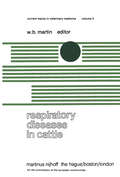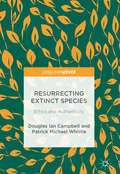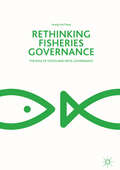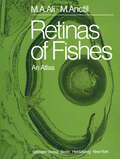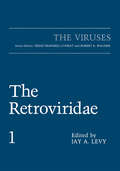- Table View
- List View
The Respiratory Burst and Its Physiological Significance
by A. J. Sbarra R. R. StraussWhen phagocytes are exposed to a number of different stimuli, they undergo dra matic changes in the way they process oxygen. Oxygen uptake increases markedly, frequently more than 50-fold; the phagocytes begin to produce large quantities of superoxide and hydrogen peroxide; and they immediately begin to metabolize large amounts of glucose by way of the hexose monophosphate shunt. This series of changes has become known as the respiratory burst. It was first believed that the major function of this respiratory burst was to generate powerful antibacterial agents by the partial reduction of oxygen. It is becoming apparent that the respiratory burst has much wider application, and its physiological function in many different biolog ical areas is clear. In this volume, we have attempted to bring together the work of experts who have published extensively on the involvement of the respiratory burst in different physiological functions. In the first three chapters, Dr. Borregaard and Dr. Berton and co-workers and Dr. Roos and co-workers bring together what is known about the respiratory burst. They present up-to-date versions of the biochemical and metabolic activities associ ated with the burst. In Chapter 4, Dr. Styrt and Dr. Klempner discuss the respiratory burst as it affects cellular ion homeostasis. Dr. Cohen and Dr. Britigan (Chapter 5) present some interesting data on the competition between the respiratory burst and bacteria for oxygen. Dr. Dobrina and Dr.
Respiratory Control: A Modeling Perspective
by F. S. Grodins A. Shivarova G. D. SwansonThe fourth Oxford Conference entitled "Control of Breathing: A Model ing Perspective" was held in September of 1988 at Grand Lake, Colorado. Grand Lake, also called Spirit Lake, was chosen for the fourth meet i ng so as to continue the meditative atmosphere of the previ ous meetings and to put the conference on a new higher plane (8,500 feet). The weather, as promised, exhibited its random-like rain showers. The snow report became essential for traveling the 12,000 foot passes to and from Grand Lake. Even the servi ces such as telephone and elect ri city proved to be uncertain. In all, the overall atmosphere of Spirit Lake contributed to an uninhibited free-style of presentation and interaction. All of us who attend the Oxford Conferences share a common interest in exploring respiratory control and the regulation of breathing. Modeling has become an adjunct to our exploration process. For us, models are tools that extend our ability to conceptualize just as instruments are tools that extend our ability to measure. And so these meetings attract physicians, physiologists, mathematicians and engineers who are modelers and modelers who are engineers, mathematicians, physiologists and physicians. Four of these physician-modelers have now passed away. They have been very important mentors for many of us. J. W. Bellville was my Ph.D. dissertation advisor at Stanford who introduced me to the intrigue of respiratory control. G. F. Filley was my colleague at the University of Colorado who enhanced my thinking about respiratory control. E. S.
Respiratory Diseases in Cattle: A Seminar in the EEC Programme of Coordination of Research on Beef Production held at Edinburgh, November 8–10, 1977 (Current Topics in Veterinary Medicine #3)
by W. B. MartinNot so many years ago little attention was paid to non-parasitic respiratory diseases of cattle because they seemed of minor importance. However, in the past twenty years, as the number of cattle kept on any farm unit increased under economic pressures, there has been a concomitant rise in the prevalence of respiratory illness. Investigations into cattle respiratory diseases have become a significant part of the research effort in most countries of Europe. Initially much work went into finding, like the alchemist's stone, the orgdnism responsible for causing cattle respiratory disease. Many viruses were isolated and over the years a long list of those recovered from the respiratory tract of cattle has been prepared. Unfortunately, few of these viruses on their own are recognised as proven pathogens and no single virus provides the complete aetiological answer to bovine respiratory disease. More recently, perhaps in despair, g~eater attention has been directed to the role of mycoplasma and, additionally. a revival of interest has taken place in the significant part played by bacteria in the later stages of res piratory disease. Now, phrases such as "multifactorial disease" are being commonly used to describe the complex situation with respiratory disease.
Respiratory Diseases of the Horse: A Problem-Oriented Approach to Diagnosis and Management
by Laurent Couetil Jan F HawkinsThe authors provide a problem-oriented approach to the assessment and management of respiratory illness in horses. The book deals first with the anatomy, function and clinical examination of the respiratory system, followed by discussion of diagnostic tests and procedures. The clinical section is focused around the cardinal presenting manifestation
Respiratory Diseases of the Horse: A Problem-Oriented Approach to Diagnosis and Management
by Laurent Couetil Jan F HawkinsThe authors provide a problem-oriented approach to the assessment and management of respiratory illness in horses. The book deals first with the anatomy, function and clinical examination of the respiratory system, followed by discussion of diagnostic tests and procedures. The clinical section is focused around the cardinal presenting manifestation
Respiratory Physiology: Understanding Gas Exchange
by Henry PrangeWhy write another small book on respiratory physiology? I have a dozen or so texts on my bookshelf that could already be used interchangeably to teach the subject. For profit, I might as well buy lottery tickets. Not that my publisher is ungenerous, you understand, it's just that the market is not that big and there are many contenders for a share. No, I write from the idealistic standpoint that I think I have something different to say, some thing that is importantly different about how gas exchange works and with an approach that is different from other authors. With few changes, basically the same text or chapters on respiratory physiology have been written, by different authors, for decades. One could almost interchange the tables of contents of most of them. Most seem to have copied the figures and concepts used by the others. Few have done more than accept and perpetu ate the conventional wisdom. In this text, I have attempted to start from fundamental principles of biology, chemistry, and physics and ask at each step, "Does it make sense?" The mechanisms and structures of gas exchange exist because, scientifically and logically, they "can't not be" as they are. The nature of our environment and the capabilities ofliving tissue are such that only certain opportunities have been available to the evolution of gas exchange.
Respiratory Pigments in Animals: Relation Structure-Function
by Jean Lamy Jean-Paul Truchot Raymond GillesThis volume is one of those published from the proceedings of the invited lectures to the First International Congress of Comparative Physiology and Biochemistry I organized at LI~e (Belgium) in August 1984 under the auspices of the Section of Comparative of the International Union of Biological Sciences. In a Physiology and Biochemistry general foreword to these different volumes, it seems to me appropriate to consider briefly what may be the comparative approach. Living organisms, beyond the diversity of their morphological forms, have evolved a widespread range of basic solutions to cope with the different problems, both organisma! and environmental, with which they are faced. Soon after the turn of the century, some biologists realized that these solutions can be best comprehended In the framework of a comparative approach integrating results of phYSiological and biochemical studies done at the organismic, cellular and molecular levels. The development of this approach amongst both physiologists and biochemists remained, however, extremely slow until recently.
Respiratory System Diseases (Advances in Experimental Medicine and Biology #980)
by Mieczyslaw PokorskiBoth communicable and noncommunicable diseases of the respiratory system are an increasing healthcare problem despite medical advances. This book aims at unraveling the mechanisms and improving the treatment of pulmonary pathologies, ranging from such common conditions like influenza and related viral infections, functional lung dysfunction, to lung lesions and others. Chapters present late-breaking findings in the diagnostics, pharmacotherapy, and clinical evidence-based decision-making to provide results that can be used to improve healthcare and quality of life. Extending new knowledge and exploring recent medical advances, the book will hopefully help enrich research and clinical experience regarding important respiratory issues. The book is intended for general practitioners and all professionals engaged in the pulmonary field, from basic scientists to clinical investigators.
Restoring the Balance: What Wolves Tell Us about Our Relationship with Nature
by John A. VucetichWolves on a wilderness island illuminate lessons on the environment, extinction, and life.For more than a quarter century, celebrated biologist John Vucetich has studied the wolves, and the moose that sustain them, of the boreal forest of Isle Royale National Park, an island in the northwest corner of Lake Superior. During this time, he has witnessed both the near extinction of the local wolf population, driven largely by climate change, and the intensely debated relocation of other wolves to the island in an effort to stabilize and maintain Isle Royale's ecosystem health. In Restoring the Balance, Vucetich combines environmental philosophy with field notes chronicling his day-to-day experience as a scientist. Examining the fate of wolves in the wild, he shares lessons from these wolves and explains their impact on humanity's fundamental responsibilities to the natural world. Vucetich's engaging narrative and unique, clear-eyed perspective provide an accessible course in wolf biology and behavioral ecology. He tackles profound unresolved questions that will shape our future understanding of what it means to be good to life on earth: Are humans the only persons to inhabit Earth, or do we share the planet with uncounted nonhuman persons? What does a healthy relationship with the natural world look like? Should we intervene in nature's course in order to care for it? Touching on the triumph and tragedy of how wolves kill moose to the Shakespearian drama of wolves' social lives, Vucetich comments on ravens, mice, winter ticks, and even a life-changing encounter he shared with a toad. Vucetich produces exquisite insight by masterfully connecting his observations to a far-reaching history of ideas about the environment. Combining natural history and memoir with fascinating commentary on humanity's relationship with nature, Restoring the Balance evokes our connections with wolves as fellow apex predators, demonstrating how our shifting views on nature have implications for both their survival and ours. This book will be treasured by any thoughtful reader looking to deepen their relationship with nature and learn about the wolves of Isle Royale along the way.
Restoring the Oceanic Island Ecosystem: Impact and Management of Invasive Alien Species in the Bonin Islands
by Kazuto Kawakami Isamu OkochiLoss of biodiversity on tropical and subtropical oceanic islands is one of the most pressing conservation issues. These oceanic islands are well known for their unique fauna and ? ora, which evolved over long periods in isolation from external perturbation. However, the maj- ity of these islands in the Paci? c were eventually settled by Polynesians and then by Europeans; by about 200 years ago, only a few island groups remained untouched. The Bonin Islands are one of these groups. The Bonin Island group is one of the most remote in the world. The islands are located 1,000 km south of Japan off the eastern fringe of Eurasia. They were ? rst discovered by the Japanese in 1670, settled by Westerners from Hawaii in 1830, and ? nally recognized as a Japanese territory in 1862 on condition that previous settlers would be protected and allowed to remain with full rights. Because of this complicated history, the Bonins have two names.
Restoring the Wild: Sixty Years Of Rewilding Our Skies, Woods And Waterways
by Roy DennisThe distinctive white-tailed sea eagle was driven to extinction in Britain more than 200 years ago, but this immense predator is making a return to our skies, thanks to Roy Dennis, an ornithologist, conservationist and arguably the driving force behind the UK’s reintroduction agenda.
Restraint and Handling of Wild and Domestic Animals
by Murray FowlerRestraint and Handling of Wild and Domestic Animals, Third Edition offers an introduction to the basic principles of animal restraint and an overview of techniques for vertebrate wild and domestic animals. Fully updated throughout, the third edition also includes new chapters on understanding behavior, training for restraint and handling, and animal welfare and restraint. Now in full color, the third edition of this classic reference is an invaluable tool to recognizing potential danger in restraint and reducing stress in the animal.
Restraint and Handling of Wild and Domestic Animals
by Murray FowlerRestraint and Handling of Wild and Domestic Animals, Third Edition offers an introduction to the basic principles of animal restraint and an overview of techniques for vertebrate wild and domestic animals. Fully updated throughout, the third edition also includes new chapters on understanding behavior, training for restraint and handling, and animal welfare and restraint. Now in full color, the third edition of this classic reference is an invaluable tool to recognizing potential danger in restraint and reducing stress in the animal.
Resurrecting Extinct Species: Ethics and Authenticity
by Douglas Ian Campbell Patrick Michael WhittleThis book is about the philosophy of de-extinction. To make an extinct species ‘de-extinct’ is to resurrect it by creating new organisms of the same, or similar, appearance and genetics. The book describes current attempts to resurrect three species, the aurochs, woolly mammoth and passenger pigeon. It then investigates two major philosophical questions such projects throw up. These are the Authenticity Question—‘will the products of de-extinction be authentic members of the original species?’—and the Ethical Question—‘is de-extinction something that should be done?' The book surveys and critically evaluates a raft of arguments for and against the authenticity or de-extinct organisms, and for and against the ethical legitimacy of de-extinction. It concludes, first, that authentic de-extinctions are actually possible, and second, that de-extinction can potentially be ethically legitimate, especially when deployed as part of a ‘freeze now and resurrect later’ conservation strategy.
Resurrecting Extinct Species: Ethics and Authenticity
by Douglas Ian Campbell Patrick Michael WhittleThis book is about the philosophy of de-extinction. To make an extinct species ‘de-extinct’ is to resurrect it by creating new organisms of the same, or similar, appearance and genetics. The book describes current attempts to resurrect three species, the aurochs, woolly mammoth and passenger pigeon. It then investigates two major philosophical questions such projects throw up. These are the Authenticity Question—‘will the products of de-extinction be authentic members of the original species?’—and the Ethical Question—‘is de-extinction something that should be done?' The book surveys and critically evaluates a raft of arguments for and against the authenticity or de-extinct organisms, and for and against the ethical legitimacy of de-extinction. It concludes, first, that authentic de-extinctions are actually possible, and second, that de-extinction can potentially be ethically legitimate, especially when deployed as part of a ‘freeze now and resurrect later’ conservation strategy.
Rethinking Fisheries Governance: The Role of States and Meta-Governance
by Hoang Viet ThangThis book explores how the state can foster collective action by fisher’s communities in fisheries management. It presents a different perspective from Elinor Ostrom’s classic work on the eight institutional conditions that foster collective action in natural resource management and instead emphasizes the role of the state in fisheries co-management, engaging a state-centric notion of ‘meta-governance’. It argues that first, the state is required to foster collective action by fishers; and secondly, that the current fisheries co-management arrangements are state-centric. The study develops these arguments through the analysis of three case studies in Japan, Vietnam and Norway. The author also makes a theoretical contribution to governance literature by developing Ostrom’s ‘society-centric’ framework in a way which makes it more amenable to the analysis of state capacity and government intervention in a comparative context. This book will appeal to students and scholars of global governance, fisheries management, co-management, and crisis management, as well as practitioners of fisheries management.
The Reticuloendothelial System: A Comprehensive Treatise Volume 9 Hypersensitivity
by S. M. Phillips M. R. EscobarThis comprehensive treatise on the reticuloendothelial system is a project jointly shared by individual members of the Reticuloendothelial (RE) Society and bio medical scientists in general who are interested in the intricate system of cells and molecular moieties derived from those cells which constitute the RES. It may now be more fashionable in some quarters to consider these cells as part of what is called the mononuclear phagocytic system or the lymphoreticular sys tem. Nevertheless, because of historical developments and current interest in the subject by investigators from many diverse areas, it seems advantageous to present in one comprehensive treatise current information and knowledge con cerning basic aspects of the RES, such as morphology, biochemistry, phylogeny and ontogeny, physiology, and pharmacology as well as clinical areas including immunopathology, cancer, infectious diseases, allergy, and hypersensitivity. It is anticipated that, by presenting information concerning these apparently het erogeneous topics under the unifying umbrella of the RES, attention will be focused on the similarities as well as interactions among the cell types constitut ing the RES from the viewpoint of various disciplines. The treatise editors and their editorial board, consisting predominantly of the editors of individual vol and enormous task umes, are extremely grateful for the enthusiastic cooperation undertaken by members of the biomedical community in general and especially and Japanese Reticuloen by members of the American as well as European dothelial Societies.
The Retina and Circadian Rhythms (Springer Series in Vision Research #1)
by Gianluca Tosini P. Michael Iuvone Douglas G. McMahon Shaun P. CollinDaily rhythms are a ubiquitous feature of living systems. Generally, these rhythms are not just passive consequences of cyclic fluctuations in the environment, but instead originate within the organism. In mammals, including humans, the master pacemaker controlling 24-hour rhythms is localized in the suprachiasmatic nuclei of the hypothalamus (SCN). This circadian clock is responsible for the temporal organization of a wide variety of functions, ranging from sleep and food intake, to physiological measures such as body temperature, heart rate and hormone release. Moreover, accumulating evidence suggests that dysfunction of the circadian rhythms due to genetic mutations or environmental factors (i.e., jet-lag or shift work) contribute to the development of many pathologies, including sleep disorders, mood and affective disorders such as major depression, bipolar disorder and schizophrenia, as well as the risk of metabolic and cardiovascular disorders.
Retinal Degeneration: Clinical and Laboratory Applications
by Joe G. Hollyfield, Robert E. Anderson and Matthew M. LaVailDuring the last few years, an explosion of infonnation has come from human genetics and molecular and cell biological studies as to the genetic basis for a number of fonns of inherited retinal degenerations. These disorders have plagued mankind for millennia because they take from otherwise healthy individuals the precious gift of sight. The fundamental advances in recent years have identified a number of genes involved in the groups of diseases which hopefully will lead to discoveries that may, in the not too distant future, allow the prevention and possible cure of some of these blinding eye disorders. To foster a forum for discussions of studies on degenerative retinal disorders, we convened a symposium on retinal degenerations in 1984, at the VIth International Congress of Eye Research Meeting, held in Alicante, Spain. Because of the success of this meeting and the subsequent publication, we have since organized a series of biennial satellite meetings on retinal degenerations for the ISER congresses held in Nagoya, Japan (1986), San Francisco (1988) and Helsinki (1990). Each of these satellite symposium on retinal degenerations was accompanied by a published proceedings volume. This volume is the fifth in this series and contains the proceedings of the Sardinia Symposium on Retinal Degeneration held September 15-20, 1992, as a satellite meeting of the 10th International Congress of Eye Research.
Retinas of Fishes: An Atlas
by Mohamed A. Ali Michel AnctilA considerable amount of information on the retinal morphology in fishes has been accumulating during the past century. Among the vertebrates, fishes are a highly successful group, both in number of species and in the adaptive radiation of forms. For instance, 415 teleost families are now recognised (GREENWOOD, ROSEN, WEITZMANN and MYERS, 1966), and the 20,000 odd fish species mentioned in text-books have been by far out numbered. The fish retina also shows considerable variations, in conformity with the extreme morphological diversification reached by piscine forms, in colonising all conceivable aquatic habitats and developing a wide spectrum of life habits. We intend to illustrate this in the present Atlas, a collection of short texts and photomicrographs of the retina from about one hundred fish families. This Atlas is intended also to fulfil other purposes. One of them is to present in a phylogenetic order the rather scattered data on fish retinal structure, with appropriate illustrative material; another is to assist the visual physiologist or biochemist in his search for a retina with particular morpholog ical features compatible with his specific requirements. In other words, what we aim at is a ready pool of information for laymen, students, and specialists of varied interests. The material used for this Atlas comes from various sources.
Retired Racing Greyhounds For Dummies (For Dummies Ser.)
by Lee Livingood“The next best thing to having an experienced Greyhound owner living with you.” —Joan Belle Isle, President, Greyhound Project “Anyone who reads this book and follows its guidance will have a happier, healthier dog and be a happier, more relaxed dog owner.” —Hal and Karen Hawley, Greyhound Friends Northwest The Greyhound has been celebrated in song and legend for thousands of years. Nowadays, Greyhounds are bred almost exclusively for racing. In the bad old days, prior to the 1980s, dogs that didn’t make the grade at the track, and those past their primes, were destroyed. According to official estimates, 60,000 of these noble, mild-mannered dogs were destroyed each year! Fortunately, a number of organizations now exist devoted to rescuing these unwanted dogs and placing them in good homes. Thinking about adopting a retired racing Greyhound? Or maybe you’re already sharing your life with one of these charming animals. Either way, this friendly guide tells you everything you need to know to: Understand the Greyhound personality Find a retired racing Greyhound to adopt Choose the right ex-racer for you and your family Educate yourself and your retired racer Give your new pal the diet and exercise it needs Keep your dog healthy and happy for years to come With plenty of good humor and straight-talk, Lee Livingood drawing on her forty-years of experience training adult rescue dogs to cover all the pros and cons of being a retired racing Greyhound owner, and she fills you in on: The amazing 8000-year history of the Greyhound Deciding whether an ex-racer is the right do for you and your family Physical and behavioral characteristics How to get a retired racer used to living in a home and be a companion Dealing with common behavioral and health problems Feeding, grooming, and exercising a Greyhound Fun things to do with your hound Bursting with expert advice on all aspects of living with an ex-racer, Retired Racing Greyhounds For Dummies is must reading for anyone considering adoption or who’s already taken the leap.
Retrograde Evolution During Major Extinction Crises (SpringerBriefs in Evolutionary Biology)
by Jean GuexThis book is the first of its kind, providing in-depth analysis of the retrograde evolution occurring during major extinction periods. The text offers a non-strictly adaptative explanation of repetition of phyla after the major extinctions, utilizing a study of seven phylogenetically distinct groups. This opens a new experimental field in evolutionary biology with the possibility of reconstructing ancestral forms in lab by applying artificial stresses.
The Retroviridae (The Viruses)
by Jay A. LevyProviding both historical background and recent advances, this series reviews in-depth the biologic, molecular, immunologic, and patholic features of this facinating virus family. The current volume focuses on the avian and murine species which have generated novel insights into cancer, and the evolution of the retroviridae.
The Retroviridae (The Viruses)
by Jay A. LevyIn this second volume in the series The Retroviridae, the readers are treated to up-to-date reviews on these viruses, which are found in a variety of animal species. The volume begins with important observations on the general fea tures of retrovirus entry into cells as determined by the viral envelope glyco proteins and the cell surface receptors (Chapter 1). Aspects of this virus-cell interaction form the basis for the variety of biologic effects associated with this virus family. A timely review of the oncogenic feline viruses is included next (Chapter 2). These viruses, along with the avian and murine retroviruses (Volume 1, Chapters 6 and 7), have provided valuable insight into cancer induction in other animal species, including humans. Two other major groups of retroviruses, the lentiviruses and the spuma viruses, are introduced in the present volume. Initially these groups, along with oncoviruses, were the three subfamilies in the Retroviridae. This com plex virus family has now been reclassified into seven separate genera (Vol ume 1, Chapter 2). Equine infectious anemia virus is the prototype for a lentivirus (Chapter 5). One of the first viruses discovered in nature (1904), it was only relatively recently recognized as a retrovirus. Lentiviruses are asso ciated primarily with immunologic disorders such as autoimmunity and AIDS (Chapters 3-5), but their association with neurologic disease is also well established (Chapters 4 and 5, and future volumes).
The Retroviridae (The Viruses)
by Jay A. Levydepth overview of the retrovirus family. I have greatly enjoyed and learned from this experience. Each chapter is an excellent introduction to the topic covered and provides a good foundation for further work in the field. Jay A. Levy University of California School of Medicine San Francisco, California REFERENCES Brown, E. W., Yuhki, N., Packer, C., and O'Brien, S. J., 1994, A lion lentivirus related to feline immunodeficiency virus: Epidemiologic and phylogenetic aspects, ,. Viral. 68:5953-5968. Merza, M., Larsson, E., Steen, M., and Morein, B., 1994, Association of a retrovirus with a wasting condition in the Swedish moose, Virology 202:956-961. Contents Chapter 1 The Human Immunodeficiency Viruses Edward Barker, Susan W Barnett, Leonidas Stamatatos, and Jay A. Levy I. Introduction .................................................... 1 TI. Description of Agent . . . . . . . . . . . . . . . . . . . . . . . . . . . . . . . . . . . . . . . . . . . . . 2 A. Virus Structure .............................................. 2 B. Genetic Organization and Gene Function ...................... 2 TIL Transmission.................................................... 7 A. General Observations ........................................ 7 B. HIV Transmission by Blood and Blood Products ................ 8 C. HIV Transmission by Genital Fluids ........................... 10 D. HIV Transmission by Other Body Fluids ....................... 12 E. Mother-to-Child Transmission ................................ 12 IV. HIV Infection of the Cell . . . . . . . . . . . . . . . . . . . . . . . . . . . . 13 . . . . . . . . . . . . . A. Introduction ................................................. 13 B. HIV-Cell Interaction............ ............... .............. 15 C. CD4-Induced gp120 Conformational Changes .................. 16 D. Soluble CD4-Induced gp120-gp41 Dissociation..... ............ 16 E. gp120 Proteolytic Cleavage ................................... 17 F. pH-Independent Membrane Fusion ............................ 19 G. Transmission of HIV by Cell-to-Cell Fusion.................... 19 H. Additional Cell Surface Receptors for HIV ..................... 20 I. The Envelope Region and Cell Tropism ........ . . . . . . . . . . . . 21 . . . .


